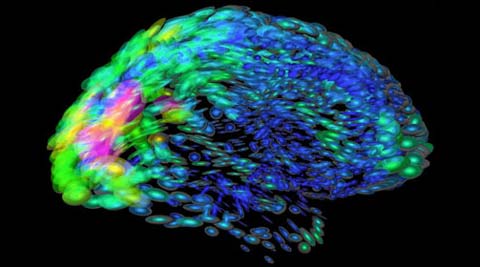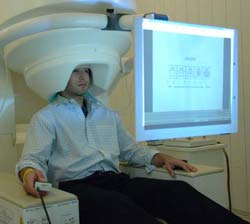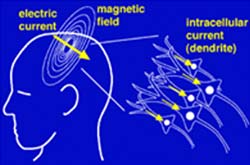Detecting Schizophrenia with Magnetic Fields
Schizophrenia affects an estimated 24 million people worldwide, according to the World Health Organization. Despite its prevalence, there’s no objective test for schizophrenia. Instead, clinicians diagnose patients with the brain disorder if over time they exhibit a set of behavioral symptoms such as hallucinations, delusions, paranoia, social withdrawal, and disorganized thinking and speech.
Physical exams can rule out other conditions with similar symptoms, but now scientists are moving closer to developing a “test” for schizophrenia based on nuances in schizophrenic patients’ electrical brain activity.

An artist's visualization of the brain.
Image Credit: Arthur Toga/PSU
The physical causes of schizophrenia are not well understood, but genetics certainly play a role. Images of the brains of schizophrenic patients indicate some differences in structure from healthy brains, and irregularities in the production of brain chemicals like dopamine and glutamate also seem to be factors.
Despite the limited understanding of its root causes, the symptoms of schizophrenia can be treated effectively with counseling and anti-psychotic medication in most cases. But treatment is most effective when started early, so an objective diagnostic test would be a very useful tool.
Researchers from laboratories in the United Kingdom and Spain, led by Dr. Javier Escudero from the University of Plymouth, are working on developing such a test. In a recent study, they compared the brain activity of people with schizophrenia to that of healthy people using magnetoencephalography (MEG), a technique for recording the magnetic fields produced by electrical activity in the brain. The results indicate some interesting differences in brain activity between those with and without schizophrenia.
The Electric, Magnetic Brain


Top: A patient undergoing an MEG Scan.
Image Credit: NIH
Bottom: How electric fields generate magnetic fields in the brain.
Image Credit: Tom Holroyd
Billions of neurons in the human brain constantly send and receive electrical signals. These signals carry messages related to thoughts and actions. Measuring the magnetic field at different points around a patient's head provides insight into the brain’s electrical activity because electricity and magnetism are deeply intertwined; a moving charge, or current, produces a predictable magnetic field.
This is true even of the tiny electrical signals generated by neurons. Consequently, MEGs are a way to record the electrical activity taking place in the brain.
Other techniques, like electroencephalogy (more commonly known as EEG), record the electrical activity taking place inside the brain, but MEG has some advantages. The magnetic fields detected by MEG are less distorted by the skull and scalp than the electrical signals recorded by EEG; MEG systems are generally more comfortable for patients; and the MEG is a more direct measurement of brain activity than an EGG due to the biology of the head and brain.
Most commercial MEG systems look kind of like an open-faced helmet, with a few hundred sensors embedded in the helmet. Each sensor measures and records the magnetic field at that location several hundred times per second. The scan takes place inside a magnetically shielded room because the magnetic fields produced by the brain are so small that fields produced by electrical equipment or other devices — and even the Earth's magnetic field — could interfere with the results.
In Escudero’s study, the researchers took at least five minutes of MEG data for 15 participants diagnosed with schizophrenia and 17 healthy participants while the participants were in a relaxed state. The MEG system had 148 data channels, or sensors.
For each person, the researchers calculated a set of features from the data that provided an overall picture of the participant's brain. Then they organized the channels into five groups based on the region of the scalp they covered — anterior, central, left, right, and posterior — and calculated the average value for each feature for each group.Magnetic Revelations
The team identified two features in particular regions of the brain that were statically different between those with and without schizophrenia. In addition, they identified four features that changed with age differently in the schizophrenic group than in the healthy group, suggesting that the disorder might affect how brain activity evolves with age.
While the results show potential, the researchers say developing a diagnostic test for schizophrenia requires much more work, especially an inexpensive test with high levels of accuracy. However, they are optimistic that further MEG studies can shed even more light on how this disorder affects brain activity and what an objective diagnostic test might look like.
This isn't the first time that people have studied the differences in brain activity between people with and without schizophrenia using EEGs and MEGs, but some previous studies have reached contradictory conclusions about how schizophrenia affects the electrical signals in the brain. One possible reason is that there are several types of schizophrenia and patients with different types exhibit different sets of symptoms. These different symptoms may reflect different abnormalities in brain activity.
To control for this, the researchers used only schizophrenic patients with similar and high degrees of what psychologists call "positive" psychotic symptoms. "Positive" refers to active symptoms such as hallucinations and delusions while "negative" symptoms refer to the loss of things like motivation and the ability to feel emotions.
Other inconsistencies between previous studies could also be due to differences in the brain activity of participants experiencing a schizophrenic episode for the first time versus participants who have had the disorder for many years. People with schizophrenia generally experience their first episode during late adolescence. In this new study, the healthy group was age-matched to the schizophrenic group to control for this and gain more insight into the evolution of the disorder.
References and Links
- Physiological Measurement: Changes in the MEG background activity in patients with positive symptoms of schizophrenia: spectral analysis and impact of age
Read the technical paper describing this research in the journal Physiological Measurement. - Athinoula A. Martinos Center for Biomedical Imaging: Magnetoencephalography (MEG)
Find out more about MEG, its uses, and how it compares to EEG on this site. - National Institute of Mental Health: Schizophrenia
Visit this site for a wealth of information about schizophrenia, finding help if you or someone that you know suffers from the disorder, treatments, related science, and more. - World Health Organization: Schizophrenia
Learn more facts about schizophrenia and its prevalence in the world, and find information on treatment programs in different countries.
-Kendra Redmond














